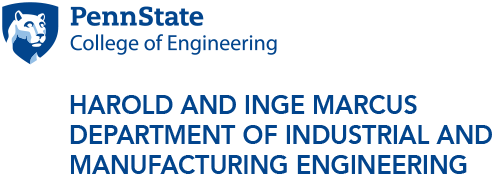
Assistant Teaching Professor Sarah Root uses case studies in her courses and finds it bring students closer to real world issues in the service sector.
IE students work with real data to tackle service sector challenges
4/12/2018
UNIVERSITY PARK, Pa. — The application of real data to classroom problems is allowing Penn State industrial engineering (IE) students to take their learning one step further. Professor Vittal Prabhu developed a case study based on data from an electric utility company to help students apply engineering techniques to real life situations.
Faculty in the Harold and Inge Marcus Department of Industrial and Manufacturing Engineering that teach service enterprise engineering (SEE) courses are challenging students in the classroom to prepare them for life after Penn State. This particular case study presents information from “ABC Electric Utility,” an investor-owned electric utility that aims to optimize every form of the electric service system while providing the most reliable service. (The company’s name has been changed for confidentiality.)
“Eighty percent of jobs in the United States are service-oriented positions so IE students need to understand how they can use the tools they are learning in the service industry,” said Jack Steele, a 1968 alumnus of the Penn State IE program who has been on the SEE advisory board since its inception in 2003. “As an advisory group to the Marcus department, members of the board seek out case studies like this because students are exposed to different areas that make up the service sector.”
When the SEE advisory board was established, the need for a case study committee was recognized. Since all the tools used to teach students were manufacturing-based, the board decided there needed to be service-based studies so students can learn about the ever-growing service sector. Currently there are 23 such case studies that range across the service industry including government, hospitals, electric utilities and hospitality.
“It’s really great to have resources like this (case study) to connect real world examples in class,” said Sarah Root, an assistant teaching professor in the Marcus department who speaks highly of using the ABC Electric Case Study in classes. “IE students using a case study like this great because it’s good for them to see how problems in a variety of different domains unfold.”
In the United States, the estimated cost of power interruptions is $79 billion per year. This issue is being tackled outside the classrooms at Penn State so students working on these challenges will advance their real-world skill set further. For all the case studies given to IE students, they are real problems that had to be solved outside the walls of the university but they are presented to students as problems that they have to solve themselves. That’s the important part of these case studies – they are all real issues that needed to be solved by IEs.
“Having classes based on real data helps students with applied learning and it’s very useful for them to have a mix of the types of information they’re working with,” said Charlie Purdum, an instructor who teaches SEE courses. Purdum uses case study assignments exclusively in the “Statistical Quality Control” and “Six Sigma Methodology” courses he teaches. “Using real data is important because it teaches students how data can be collected and used to improve an operation,” he said.
There are two main benefits of using service-based case studies, Steele explained. First, is that students can now look at a case study and see how IE is applicable in the specific service area.
For example, there are case studies from Hershey Medical Center that can help students decide if health care is a field they would like to focus on in their careers.
The second benefit is to convince students to go into the service sector.
“These case studies will help students see what it looks like to apply what they’re learning in real-life scenarios,” Steele explained. “Since so many jobs these days are service-based, a large percentage of students will choose to go into the service sector due to job availability, so giving them the information they need to help make those decisions is imperative.”
The SEE board has developed case studies so that every service industry is represented and every major SEE course has a case study. Moving forward, a goal is to get more capstone projects to be service-based. Only 33 percent of capstone design projects in the fall were service-based, but if more projects focus on the service sector, they can also be used as case studies to help future students learn.
Prabhu and the rest of the SEE 360 advisory board continue to provide other faculty with these resources. It helps not only expands the future potential of students but it enhances their educational opportunities at Penn State as well.



